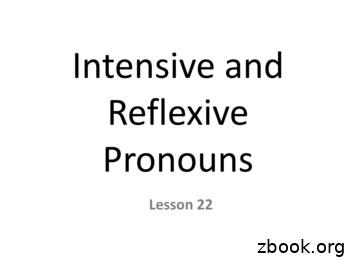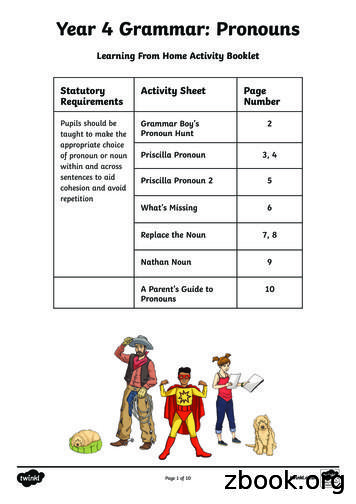Chapter 1 Pronouns
Chapter 1PronounsIntroductionThis chapter focuses on pronouns and the role theyperform in substituting for nouns. After revising themeaning and use of nouns, the activities introduceand look at different pronouns, considering the‘person’ they represent and how they develop clarityand cohesion in texts and writing. Throughout thechapter there is an emphasis on exploring thesegrammatical features in real contexts – such as texts,comics and conversations. For further practice, pleasesee the ‘Pronouns’ section of the Year 3 workbook.Poster notesPronouns (page 10)This poster presents the various words that canfunction as personal pronouns. They are organisedinto rows of singular and plural pronouns. The posterprovides an opportunity for children to think ofsentences where they would use particular pronouns.Person (page 11)The same pronouns are organised into the first,second and third person. Use the poster to helpchildren appreciate the use of different ’persons’ inwriting. First-person pronouns: identify with the speakeror writer, either alone (‘I swam’, ‘my lunch’) or as partof a group (‘we swam’, ‘our house’). Second-person pronouns: identify with the onebeing addressed in speech or writing (‘you mustremember’, ‘your bike’). Third-person pronouns: identify with a third partyor thing who is neither the one addressing nor theone addressed (‘her book’, ‘he shouted’).In this chapterNounspage 12Pronounspage 16Pronouns taketheir placepage 20To revisit nouns.To recognise and identifypronouns.To choose pronouns appropriately.Pronounsin textpage 24To investigate the use of pronouns.Pronounsin writingpage 28To extend the use of pronouns inwriting.VocabularyChildren should already know:nounIn Year 3 children need to know:pronounScholastic English SkillsGrammar and punctuation: Year 39
I10Scholastic English SkillsGrammar and punctuation: Year imselfyourselfmyselfyoursyoumeChapter 1Poster 1www.scholastic.co.uk
Chapter 1Nouns Photocopiable page 15 ‘Missing words’ObjectiveTo revisit nouns.geBackground knowledNouns are words that name concrete things orabstract thoughts and feelings. This class of wordsincludes all words that can act as subjects in asentence, so if a word can follow the articles ‘a’, ‘an’or ‘the’ in a sentence then it is a noun. This meansthat words like ‘walk’, which would commonly beclassed as a verb, can be classed as a noun in asentence like We are going for a walk. The verb hereis ‘going’, because that is the action ‘we’ are taking.Nouns can often be detected by the way they can beturned from singular to plural and vice versa. In thisexample ‘we’ could go for a number of ‘walks’: Weare going for a few walks. Although the plurals mademay seem odd, the pluralisation rule acts as anotheruseful test for most nouns, excluding irregular pluralssuch as ‘mice’ and non-countable nouns suchas ‘sugar’.Activities Photocopiable page 13 ‘Is this a noun?’In applying the ‘a’, ‘an’ or ‘the’ test, children can beasked to think of a context in which a construction canwork. It is difficult to think of an example in which wewould say ‘a soft’ but we can imagine talking about‘a jump’ in a context like She did a brilliant jump. Thishelps us to determine which of these two words couldbe used as a noun. Photocopiable page 14 ‘Finding nouns’As children swap the nouns around in this activity, theywill need to check that the sentences they make includeconsistent uses of single and plural nouns, as well aspunctuation.12Scholastic English SkillsGrammar and punctuation: Year 3In each of the sentences on the photocopiable sheetthere is a range of nouns that could be used to fill thespaces. Children can work in twos and threes to comeup with a list of possibilities for each of the spaces.They can then think about how some of their chosenalternatives could be used in a short story idea, whichthey can plan together.Further ideas Headlines: Look at the headlines of newspaperstories. Ask the children to find words that are used asnouns in the headlines but could be used as verbs in adifferent sentence, for example: Talks crumble in unionrow. They can cut out the words and create the newsentence around them. Dictionary nouns: Taking any page in the dictionary,ask the children to go through the words listed, testingthem to see if they could be used as nouns. Jumble sentences: Ask the children to take severalsentences from a story and jumble the nouns around tomake a nonsensical opening.Digital contentOn the digital component you will find: Printable versions of all three photocopiable pages. Answers to ‘Is this a noun?’. Interactive version of ‘Is this a noun?’.
Name:Chapter 1nounPrnssroernouPoptake their placeMissing pronouns Look at the gaps in the sentences below. Find a word below that fits ineach gap.hers mine weyou yourself himtheyI us she he our itthey herself them yoursThe animals were at a party.to cheerwere bored. Monkey wantedup. She found a tree stump and jumped on.She shouted to the animals “Heydid a funny dance.lot – look at me.” Shebopped and jived. The animals laughedso loudlygave themselves tummy aches. The camel wasnot pleased.was so jealous.When the monkey was finished he clambered onto the tree stump.“If she can do it so can“I bet,” he thought. He did a dance.is better than,” he said to.The animals thought camel was awful. They shouted “rubbish. What do you takefor?want any old dancing. Bring backsent22Scholastic English SkillsGrammar and punctuation: Year 3isdon’tfriend the monkey.” Theypacking.PHOTOCOPIABLEwww.scholastic.co.uk
Name:Chapter 1untisngnsithinnworiWPrirotinnoguwAutobiography planner Use this planner to make notes and plan a recount of your own life story. Remember to think of: the events that will interest the readers the characters who appeared in your story things people said at the time.Being bornWhen I was very littleMy familyMy first memoriesFavourite day outMeeting someone special30Scholastic English SkillsGrammar and punctuation: Year 3First day at schoolMaking friendsPHOTOCOPIABLEwww.scholastic.co.uk
page 20 To choose pronouns appropriately. Pronouns in text page 24 To investigate the use of pronouns. Pronouns in writing page 28 To extend the use of pronouns in writing. oduction oster notes Pronouns (page 10) This poster presents the various words that can function as personal pronouns
Personal Pronouns I, you, he, she Possessive Pronouns my, his, her, mine, ours, theirs Reflexive Pronouns myself, herself, himself Reciprocal Pronouns each other, one another Indefinite Pronouns anything, somebody, everyone, few, both, neither Relative Pronouns who, which, what, that, when, where Inter
Lesson 22 t Intensive and Reflexive Pronouns Reflexive Pronouns Reflexive pronouns are a bit different from the other kinds of pronouns. They cause the verb to reflect back on the subject . In other words, reflexive pronouns are used when the subject of the sentenc
Part One: Heir of Ash Chapter 1 Chapter 2 Chapter 3 Chapter 4 Chapter 5 Chapter 6 Chapter 7 Chapter 8 Chapter 9 Chapter 10 Chapter 11 Chapter 12 Chapter 13 Chapter 14 Chapter 15 Chapter 16 Chapter 17 Chapter 18 Chapter 19 Chapter 20 Chapter 21 Chapter 22 Chapter 23 Chapter 24 Chapter 25 Chapter 26 Chapter 27 Chapter 28 Chapter 29 Chapter 30 .
page 2. Grammar Boy’s Pronoun Hunt. 1. I 2. he 3. his 4. ours 5. mine 6. yours 7. she 8. it 9. they Year 4 Grammar: Pronouns Answers page 3, 4. Priscilla Pronoun. Personal Pronouns Possessive Pronoun Relative Pronouns Reflexive Pronouns Demonstrative Pronouns I you he she it we they me him
Part 1: Personal Pronouns Singular Personal Pronouns I me my, mine you you your, yours he, she, it him, her, it his, hers, its Let’s Run a Drill! Directions: Underlinethe personal pronouns in the following sentences. (The number of personal pronouns in each sentence is given in parentheses.) Plural Personal Pronouns we
repetition of using his name again. Please see below for a list of personal pronouns: Possessive Pronouns Possessive pronouns show ownership or who something belongs to. They are: mine, yours, his, hers, its, ours, yours, theirs. Relative Pronouns Relative pronouns are: who, whose,
Pronouns Relative pronouns have different functions They introduce a clause (the part of a sentence that gives more information about the noun). They connect the clause to the rest of the sentence. Relative pronouns can be found in sentences with more than one clause. o I cannot believe that she said it. o He who begins late finishes last
Andreas Wagner Head of Building Science Group Karlsruhe Institute of Technology Department of Architecture. Background Occupant behaviour has a strong influence on building energy performance Reasons for occupants’ interventions: dissatisfaction with building automation interfaces are not designed/equipped for intended purpose designers / building managers do not fully consider –or .























